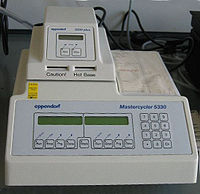
Amplicons
Encyclopedia

DNA
Deoxyribonucleic acid is a nucleic acid that contains the genetic instructions used in the development and functioning of all known living organisms . The DNA segments that carry this genetic information are called genes, but other DNA sequences have structural purposes, or are involved in...
formed as the product of natural or artificial amplification events. For example, it can be formed via polymerase chain reaction
Polymerase chain reaction
The polymerase chain reaction is a scientific technique in molecular biology to amplify a single or a few copies of a piece of DNA across several orders of magnitude, generating thousands to millions of copies of a particular DNA sequence....
s (PCR) or ligase chain reaction
Ligase chain reaction
The ligase chain reaction is a method of DNA amplification. While the better-known PCR carries out the amplification by polymerizing nucleotides, LCR instead amplifies the nucleic acid used as the probe. For each of the two DNA strands, two partial probes are ligated to form the actual one; thus,...
s (LCR), as well as by natural gene duplication
Gene duplication
Gene duplication is any duplication of a region of DNA that contains a gene; it may occur as an error in homologous recombination, a retrotransposition event, or duplication of an entire chromosome.The second copy of the gene is often free from selective pressure — that is, mutations of it have no...
.
Artificial amplification can be used to determine sex from a human DNA sample. The loci
Locus (genetics)
In the fields of genetics and genetic computation, a locus is the specific location of a gene or DNA sequence on a chromosome. A variant of the DNA sequence at a given locus is called an allele. The ordered list of loci known for a particular genome is called a genetic map...
of Alu element insertion is selected, amplified and evaluated in terms of size of the fragment. The sex assay utilizes AluSTXa for the X chromosome, AluSTYa for the Y chromosome, or both AluSTXa and AluSTYa, to reduce the possibility of error to a negligible quantity. The inserted chromosome yields a large fragment when the homologous region is amplified. The males are distinguished as having two DNA amplicons present, while females have only a single amplicon. The kit adapted for carrying out the method includes a pair of primers to amplify the locus and optionally polymerase chain reaction reagents.

